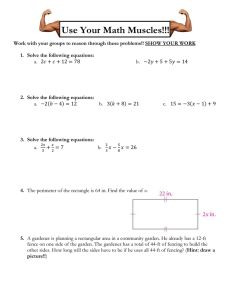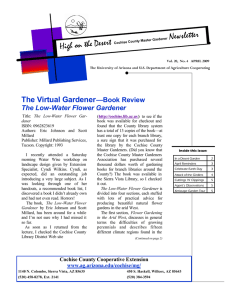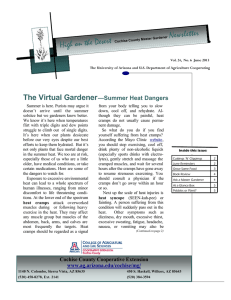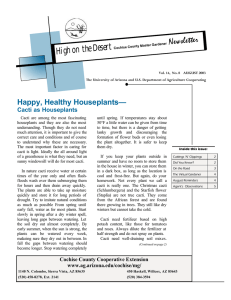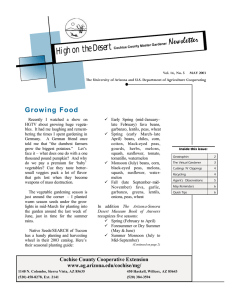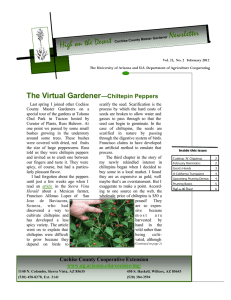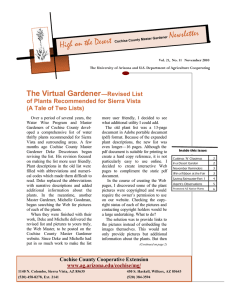High on the Desert
advertisement
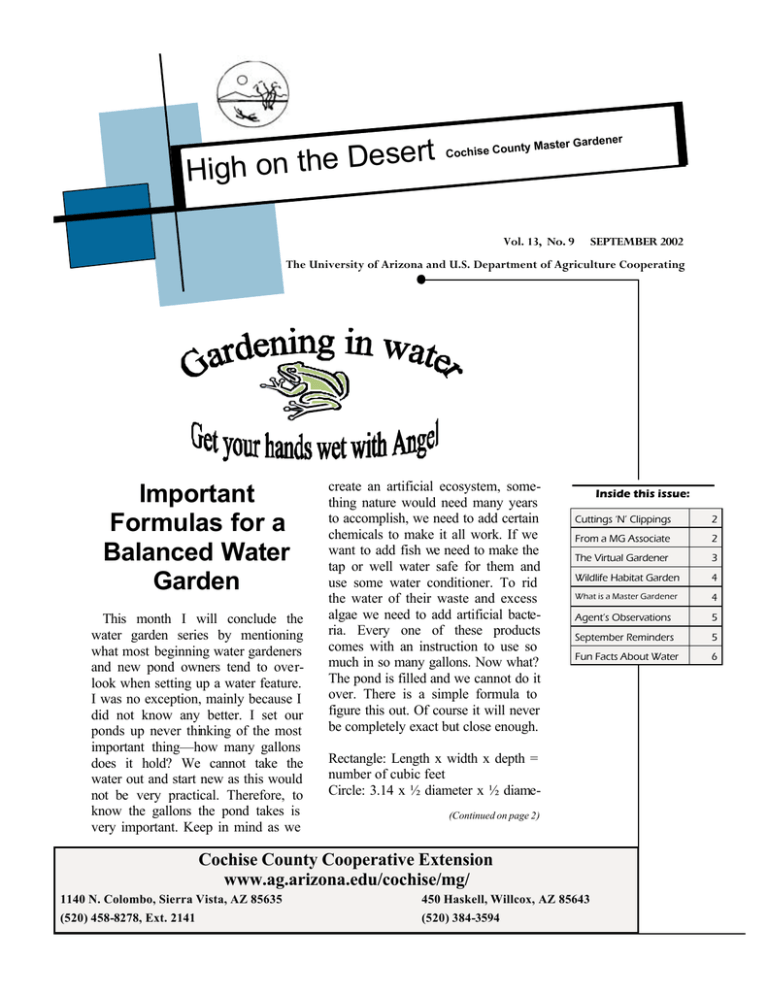
esert D e h t n o h ig H ardener nty Master G Cochise Cou Vol. 13, No. 9 SEPTEMBER 2002 The University of Arizona and U.S. Department of Agriculture Cooperating Important Formulas for a Balanced Water Garden This month I will conclude the water garden series by mentioning what most beginning water gardeners and new pond owners tend to overlook when setting up a water feature. I was no exception, mainly because I did not know any better. I set our ponds up never thinking of the most important thing—how many gallons does it hold? We cannot take the water out and start new as this would not be very practical. Therefore, to know the gallons the pond takes is very important. Keep in mind as we create an artificial ecosystem, something nature would need many years to accomplish, we need to add certain chemicals to make it all work. If we want to add fish we need to make the tap or well water safe for them and use some water conditioner. To rid the water of their waste and excess algae we need to add artificial bacteria. Every one of these products comes with an instruction to use so much in so many gallons. Now what? The pond is filled and we cannot do it over. There is a simple formula to figure this out. Of course it will never be completely exact but close enough. Inside this issue: Cuttings ‘N’ Clippings 2 From a MG Associate 2 The Virtual Gardener 3 Wildlife Habitat Garden 4 What is a Master Gardener 4 Agent’s Observations 5 September Reminders 5 Fun Facts About Water 6 Rectangle: Length x width x depth = number of cubic feet Circle: 3.14 x ½ diameter x ½ diame(Continued on page 2) Cochise County Cooperative Extension www.ag.arizona.edu/cochise/mg/ 1140 N. Colombo, Sierra Vista, AZ 85635 450 Haskell, Willcox, AZ 85643 (520) 458-8278, Ext. 2141 (520) 384-3594 PAGE 2 (Continued from page 1) ter x depth = number of cubic feet—there are 7.5 gallons of water per cubic foot—therefore multiply 7.5 x number of cubic feet to find number of gallons. In all cases vertical sides and level bottoms are assumed. With sloping sides or plant shelves the numbers are not quite as accurate. Stocking formula for a balanced pond: Two bunches of submerged (oxygenating) plants per square yard of pond surface. One water lily for each square yard of surface area or enough floating plants to cover 60% of the ponds surface during summer. Two inches of fish (length) for each square foot of pond surface in a pond 18 to 24 inches deep, or one Koi for each 25 square feet. Eight to ten small snails, optional. Or even better, 1 goldfish for 30 gallons and 1 Koi for every 125 gallons. Enjoy your water garden! Angel Rutherford, Master Gardener NOTE: If you are in need of water plants give me a call at 459-4115. I keep a variety of beautiful plants. Robert E. Call Extension Agent, Horticulture Carolyn Gruenhagen Editor Cuttings ‘N’ Clippings ?? Cochise County Master Gardeners Association (CCMGA) next meeting will be September 4 at 5:00 at the Sierra Vista library. The scheduled speaker is Gary Gruenhagen with a presentation on Global Warming and Columbia University’s Biosphere 2 Center. ??The Water Wise lecture series Saturday, Sept. 7 is Planting Techniques, a presentation by DeForest Lewis, Certified Arborist and Coc hise County Master Gardener. The free lecture takes place at the University of Arizona South, 1140 N. Colombo, Sierra Vista at 9:00 a.m. Following the lecture you may head out for the Fall Xeriscape Tour. It is scheduled for 9 a.m. to 1 p.m. in the Sierra Vista area. This is not a garden tour but a low water use landscape tour. Maps of the gardens on display will be available at the Water Wise lecture or from the Cooperative Extension, Sierra Visa. ? ??The Cochise County fair is September 25—29 at the fairgrounds in Douglas, AZ. ??The Water Wise lecture series continues on October 5. The presentation will be Greywater in the Landscape by Cado Daily, Water Wise Conservation Educator. The free lecture takes place at the University of Arizona South, 1140 N. Colombo, Sierra Vista at 9:00 a.m. Testimonial of a Master Gardener Associate . . . After I completed my Master Gardener course this spring I decided I wanted to be certified. How was I to reach the fifty-hour requirement for certification? I considered the many options available and decided I would focus on answering the phone at the Master Gardener desk. At first I was apprehensive. I knew that despite having passed the course I still was a beginner and I would not be able to answer a majority of the questions that would be posed to me. Well, my desire to be certified overcame my fears and I gave it a try. I resolved that if I failed miserably in my first attempt I would switch to an alternate opportunity. Most of the questions are waiting for you on voice mail or on the computer when you report for work. This gives you an opportunity to research, find the solution, and give correct answers. All of the people I have spoken to so far have been reasonable and appreciative. No reason at all to be scared. Fortunately my first few hours were uneventful and I was able to familia rize myself with the reference library. There are books on the full range of gardening subjects, two well indexed files containing hundreds of brochures that can be mailed, and case histories of questions and answers that have been processed over the last several years. Extension Agent, Rob Call, can be called if an urgent question has to be answered as soon as possible. Actually, I’m having fun and I intend to continue volunteering at the call desk after certification. Deke Descoteaux Master Gardener Associate PAGE 3 The Virtual Gardener—Biosphere 2 Center A couple of weeks ago Carolyn and I stayed overnight at Biosphere 2 near Oracle, Arizona and took inside and outside tours of the facility. It has been 11 years since we were last there and the changes are amazing. Of particular interest to me was the amount of research going on there. Here are a few facts about the place for those of you who might not be familiar with it. Biosphere 2 was built in the mid- to late-1980s as a completely closed system designed to house eight people for two years in a completely self-sustaining environment. In addition to the people, the facility contained four natural biomes—a rainforest, a savannah, a desert, and a coral reef—an agricultural biome, and living facilities for the people. In effect, it was a giant terrarium covering an area of 3.15 acres. The eight biospherians entered Biosphere 2 on 26 September 1991 and emerged on 26 September 1993. As it turned out, they were not able to sustain themselves without external support for the two years…but that is a story for another day. In January 1996 the Lamont Doherty Earth Observatory of Columbia University took over management of Biosphere 2 and now runs it as a teaching and research facility. The research being conducted there is unique because there is no other facility in the world that offers such large controlled environments for the study of natural ecosystems. Because the atmosphere within the closed system can be easily modified much research being done there is focused on issues involving the impact of atmospheric carbon dioxide on plant growth and global warming. During the day plants take carbon dioxide molecules from the atmos- phere and water, split them into their constituents using the process of photosynthesis, and utilize the pieces to build sugars and tissues. The oxygen that is left over is returned to the atmosphere. During the process of respiration both plants and animals utilize the oxygen in the atmosphere to burn the sugars and other tissues to create energy to carry on life processes. The byproducts of respiration are carbon dioxide and water, the raw materials of photosynthesis. At first blush, it might seem that photosynthesis and respiration cancel each other, but plants retain large amounts of carbon in their tissues for long periods of time, thus effectively removing it from the atmosphere and leaving an excess of oxygen. This is sometimes referred to as carbon sequestration. In the case of plants that were turned into coal and petroleum before they decomposed or were eaten, the sequestration lasted for millions of years. One of the ongoing experiments at Biosphere 2 today studies the effect of different levels of atmospheric carbon dioxide on the growth of cottonwood trees (Populus deltoids). For this experiment, the former agricultural biome is divided into three bays in which carbon dioxide levels are separately controlled. By making exact measurements of carbon consumed by photosynthesis and carbon produced by plant and soil respiration, scientists can determine the carbon budget and make predictions on the abilities of forests to mitigate the increase in atmospheric carbon dioxide caused by the burning of fossil fuels and wood. Another experiment on the rainforest biome concluded that there are limits to the amount of carbon dioxide that can be absorbed by forests. In essence they established a saturation level for the amount of carbon dioxide rainforests are capable of absorbing. This has great implications for long-term predictions of carbon dioxide levels in the atmosphere. If you would like to learn more about Biosphere 2 and some of the research being conducted there, point your browser to http://www. bio2.edu/ Until next time, happy surfing. Gary A. Gruenhagen, Master Gardener gruenha@sinosa.com PAGE 4 Creating a Wildlife Habitat Garden—Basic #3–Shelter Animals need shelter to escape from heat, wind, rain, and predators. As you will see next month providing shelter will also create places to raise young—basic #4. BIRDS & HUMMINGBIRDS ? Clustering plants into thickets will shelter birds and animals against wind, weather, and predators. ? Native shrubs and trees that do not provide food do provide valuable places for nesting, roosting sites, song perches, and hunting perches. ? If possible construct brush piles, rock piles, and create meadow patches for cover. ? Dead logs and trees are called “snags” and provide areas for birds to eat wood boring insects as well as provide nesting cavities for birds. BUTTERFLIES ? Sunshine - Butterflies are solar-powered so locate the garden in a sunny area. Butterflies are active on warm, windless, sunny days when temperatures are between 65°95°F. Warm rocks provide areas for “basking.” ? ? ? Shade - Butterflies will seek shady areas of the garden when daytime temperatures rise above 95°F. Windbreaks - Sheltering the butterfly garden helps butterflies so they are not cooled by winds and will not have to extend extra energy searching for food, mates, and laying eggs. A horseshoe-shaped garden is an easy and fun way to provide sunshine, shade, and windbreaks! Rock piles and brush piles are great places for shelter. A few days after I built my first brush pile I watched a hawk chase a bunch of quail through the yard. The quail safely escaped into the mass of limbs and grass. Brush piles may not be suitable for small yards. Guide to Bird Homes and nest box plans for bluebirds can be found at at http://www.nabluebirdsociety. org/plans.htm If space allows try to have one or two evergreens which will provide year round cover. During the hot weather birds and other ground dwelling animals will gravitate to the shade provided by mesquites, pines, and desert broom. Cheri Melton Master Gardener Cheri’s “What To-Do” List September in the High Desert can still be cool and wet! ? You may want to erect a couple of nesting boxes. Common birds that use nest boxes are bluebirds, cactus wrens, woodpeckers, owls, kestrels, and bats. ? Our local bird store sells nesting boxes or you can build your own. A couple of resources is the Bird Watcher’s Digest publication A ? I love planting in September. It’s a good time to visit the fall plant sales for trees, shrubs and flowers. Summer blooming plants will start setting seeds—try to curb your instinct to prune and watch the birds find and eat the seed bounty. If you have cosmos in the garden try your hand at ID’ing butterflies. What is a Master Gardener? The Master Gardener program began in King and Pierce Counties of Washington state in 1972 when an over-worked Horticultural Extension Agent, Dr. David Gibby, began training volunteers to assist him in providing support to the community. Dr. Gibby’s program was simple and effective. In exchange for a promise to donate a certain number of hours service, he gave volunteers specialized university-level training in horticulture. In 1987 Horticultural Extension Agent, Dr. Deborah Young, started the Master Gardener program in Cochise County. The current agent, Rob Call, continues the program, teaching the 13-week course yearly. Prospective Master Gardeners who take the course study such topics as soil, pest manage- ment, botany, gardening, landscaping, and environmental stewardship. Upon completion of the course the person provides educational leadership to the community by donating fifty hours of volunteers hours. For more information call one of the Cooperative Extension offices. The next class will be in Spring 2003. PAGE 5 The Agent’s Observations Q Are there any garden vegetables that I can plant for a fall harvest? Actually fall is my favorite time to garden in Southeastern Arizona. Many of the cool-season crops, those that can withstand freezing, do very well in Cochise County during the fall. In fact the fall in Cochise County is generally a better time to raise cool-season crops. These vegetables include the cabbage family, i.e., broccoli, cauliflower, kale, and cabbage among others. Also, spinach, small beets, peas—both snap and edible pod, turnips, radishes, lettuce, mustard greens, and other greens can be planted. The onion family does best when planted in the fall and then over wintered and harvested in early summer. Members include garlic, leeks, onions, and chives. If planting bulb-type onions be sure they are short-day types. Prepare and plant during the last week in August or first two weeks in September. I have had broccoli, cabbage, cauliflower, and onions growing the whole winter long during mild winters, pulling the plants out in May to make way for warm-season crops. During the cold winter months of January and February they did not grow much but they survived. A I have a bug that is eating my tomatillo’s leaves, stems, and fruits. It is about as big around as a little fingernail and has a clear yellow-brown shell. What si it and how do I get rid of it? Q After examining a sample it was determined that your tomatillo eating bug was a mottled tortoise beetle (Deloyala guttata ). The beetle is 5-6 millimeters in length. The ”shell” is transparent pale yellowish-brown with irregular yellow patches. This beetle is found in most of the United States and is a general feeder on most vegetable plants. Control: Rid yourself of this insect by applying your favorite insecticide or hand picking. Source : Insect Pests of Farm, Garden, and Orchard, Eighth Edition. 1987. Ralph H. Davidson and William F. Lyons. Jon Wiley & Sons, Inc., New York. pp. 331332. A Robert E Call Extension Agent, Horticulture Bisbee Farmers Market The Sierra Vista Area Gardeners Club is joining the Bisbee Farmers Market for a fall plant & seed sale and exchange on September 14 at the market from 7:30 a.m. to 11:30 a.m. at the Vista Park in the Warren section of Bisbee. On September 21 from 10:00 a.m. to 2:00 p.m. the Cochise County Health Department is also joining with the market and the Bisbee Food Coop for Cochise County’s First Annual Health & Harvest Wellness Festival. For more information call (520) 432-7066 September Reminders Fall Xeriscape Tour v ?Keep on watering! Saturday, Sept. 7 9:00 a.m.—1:00 p.m. Call Sierra Vista Extension Office for a map—458-8278, 2141 v Start shopping for bulbs (Bulbs for Southern Arizona bulletin is available from the Cooperative Extension offices) v ?You can always plant something—try cool-season veggies Issued in furtherance of Cooperative Extension work, acts of May 8 and June 30, 1914, in cooperation with the United States Department of Agriculture, James A. Christenson, Director, Cooperative Extension, College of Agriculture and Life Sciences, The Univ ersity of Arizona and Arizona Counties cooperating. The University of Arizona College of Agriculture and Life Sciences is an equal opportunity employer authorized to provide research, educational information and other services only to individuals and institutions that function without regard to sex, race, religion, color, national origin, age, Vietnam Era Veteran’s status, or disability. The information given herein is supplied with the understanding that no discrimination is intended and no endorsement by Cooperative Extension is implied. Any products, services, or organizations that are mentioned, shown, or indirectly implied in this publication do not imply endorsement by the University of ARIZONA COOPERATIVE EXTENSION U.S. DEPARTMENT OF AGRICULTURE Cochise County 450 S. Haskell Avenue Willcox, AZ 85643-2790 OFFICIA L BUSINESS PENALTY FOR PRIVATE USE $300 PRSRT STD POSTAGE & FEES PAID USDA PERMIT NO. G268 Return Service Requested Fun Facts About Water: ? One gallon of water weighs 8.34 pounds. ? Ninety-seven percent of earth’s water is saltwater in oceans and seas. Of the 3% that’s freshwater, only 1% is available for drinking, the remaining 2% is frozen in polar ice caps. ? About 48,000 gallons of water are needed to produce the typical American Thanksgiving dinner for eight people. ? 400 gallons of water are recycled through our kidneys each day. ? You can refill an 8-oz. glass of water approximately 15,000 times for the cost of a six-pack of soda. ? An average of 800,000 water wells are drilled each year in the US. That’s tapping into our underground-water supplies at approximately 100 times each hour for domestic, farming and commercial needs. ? About 60,000 public water systems across the US. process 34 billion gallons of water per day for home and commercial use. 85% of the population is served by these facilities. Did You Know? ? Fish eat up to 5% of their body weight daily. ? A grass lawn 10’ x 100’ consumes more than 27,000 gallons of water annually. ? Floating duckweed is the world’s simplest and smallest flowering plant. It has no true leaves or stems and appears as tiny green specks on the water’s surface. ? When Captain Cook landed at Kauai in 1778 he counted 360 fishponds covering 6,000 acres and producing about two million pounds of fish per year. ? Water lilies, lotus, and other aquatic plants reduce pond evaporation by 10%. ? Goldfish, descendants of the common crucian carp, were cultivated by the Chinese as early as the 10th century AD. ? There are more than 70 species of water lilies. Source: Water Gardens Magazine Angel Rutherford, Master Gardener



